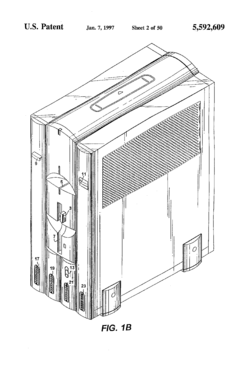| Site Notice |
|---|
|
We have a limited coverage policy. Please check our coverage page to see which articles are allowed. |
Difference between revisions of "Game Processor"
Torchickens (talk | contribs) (→Trivia) |
Torchickens (talk | contribs) (→Games) |
||
| Line 45: | Line 45: | ||
*Asterisk's Adventure (アスタリスクの大冒險) | *Asterisk's Adventure (アスタリスクの大冒險) | ||
===Game tora no Ouana - HAL College Special=== | ===Game tora no Ouana - HAL College Special=== | ||
| − | *Easy Racer | + | *[[Easy Racer]] |
| − | *Sweet Honey Action | + | *[[Sweet Honey Action]] |
| − | *PAずLE & BREっど (Puzzle & Bread) | + | *[[Puzzle & Bread|PAずLE & BREっど]] (Puzzle & Bread) |
| − | *FLOWER | + | *[[FLOWER]] |
| − | *Radio Puzzle (ラジパズ) | + | *[[Radio Puzzle]] (ラジパズ) |
| − | *Wonderful my race | + | *[[Wonderful my race]] (developer: [[YAB]]) |
<ref>[https://luigiblood.neocities.org/gameprocessor Nintendo GAME PROCESSOR - Documentation (LuigiBlood)]</ref> | <ref>[https://luigiblood.neocities.org/gameprocessor Nintendo GAME PROCESSOR - Documentation (LuigiBlood)]</ref> | ||
| + | |||
==Staff== | ==Staff== | ||
Revision as of 16:13, 26 October 2023
The Game Processor is a special software development kit by Nintendo/Intelligent Systems. The hardware was used by students at the HAL College of Technology & Design. The Game Processor was made because the Nintendo & Dentsu Game Seminar was relatively popular. Nintendo received more applicants than they could manage, which lead to more game design sessions at HAL College of Technology & Design.[1] The main software for it is Mario Factory, which allows the creation of Super Famicom compatible games.
Satoshi Yamato, Satoshi Nishiumi, Toshiaki Suzuki, Toshiyuki Nakamura, Makoto Kimizuka take credit as inventors of the Game Processor.[2]
From January 1996, Nintendo and St.GIGA would distribute six Game Processor games in various HAL College Special editions of the Game Tora no Ouana Satellaview magazine series.
The concept of Mario Factory is similar to Nintendo's consumer software creation tools in video games, spanning from early games such as Family BASIC to later games such as Game Builder Garage.
Contents
Hardware
The setup contains a 32-bit computer and Super Famicom hardware. Video output uses the "Super Impose" technology in which outputs are overlaid by each other, similar to Sega's 32X. The kit is plugged into a consumer TV with four controller ports, with compatibility for Super Famicom controllers, the SNES Mouse and a unique keyboard.
Based on a patent, the specifications are:
Game Processor 32-bit "Main" hardware:
- CPU: NEC V810 @ 21.477 MHz (32-bit RISC CPU)
- Display: S-PPU (Super Famicom PPU)
- RAM: 4 MB DRAM, can be expanded to 24 MB
- ROM: 1 MB BIOS ROM, contains Boot, OS and Fonts
- Internal Storage: 1 MB FLASH Memory
- External Storage: 3.5" Floppy Disk Drive
- Security: ID Card (CIC), can contain configuration information
- Expansion Slots: Modem Slot, SCSI Expansion Board Slot (to IBM PC Compatible, Scanner, Printer, Hard Disk Drive...)
- Real Time Clock
Super Famicom:
Game Processor Super Famicom "Game" hardware:
- ROM: 128 KB Monitor BIOS ROM
- Slots: 4 Controller Slots (Controller, Mouse, Keyboard), Microphone Jack
- Game Processor RAM Cassette
- Game Processor RAM Cassette (GPC-RAMC-4M) hardware:
- RAM: 512 KB SRAM, Battery-backed
- Battery: CR2025, replaceable
- RAM Map: Mode 21 (HiROM)
- Write Protection: 4-bit counter-based (74LS191)
- Security: CIC F411B
Games
- Mario Bros. (Sample Game) (compatible with SNES Mouse)
- Asterisk's Adventure (アスタリスクの大冒險)
Game tora no Ouana - HAL College Special
- Easy Racer
- Sweet Honey Action
- PAずLE & BREっど (Puzzle & Bread)
- FLOWER
- Radio Puzzle (ラジパズ)
- Wonderful my race (developer: YAB)
Staff
Nintendo:
- Satoshi Yamato (producer)
- Satoshi Nishiumi (hardware design)
- Toshiaki Suzuki (coordinator, director)
- Takuji Hotta (programmer)
- Kazuhiro Fujiwara (circuit design)
- Nobuhito Koganezawa (programmer)
- Yuichi Ozaki (sound)
- Toshiro Hibino
- Akiya Sakamoto (mechanical design)
- Kazunari Suga
Intelligent Systems:
- Toshiyuki Nakamura (programmer)
- Makoto Kimizuka
- Go Matsuda (bitmap editor instruction manual cover)
See also
Patents:
- US5592609A - Video game/videographics program fabricating system and method with unit based program processing
- US5599231A - Security systems and methods for a videographics and authentication game/program fabricating device
- US5680533A - Videographics program/video game fabricating system and method
- US5680534A - Video game/videographics program fabricating system and method with superimpose control
- US6115036A - Video game/videographics program editing apparatus with program halt and data transfer features
Trivia
- The title screen artwork from Mario Bros. (Sample) was used as a basis for the title screen of the Mario Bros. minigame in Super Mario Advance, Super Mario World: Super Mario Advance 2, Super Mario Advance 4: Super Mario Bros. 3 and Mario & Luigi: Superstar Saga for the Game Boy Advance.
|
| ||||||||||||
